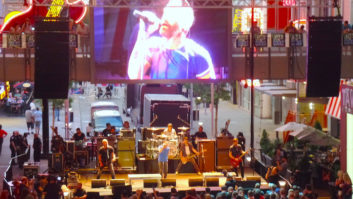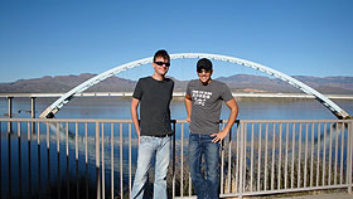ART ALEXAKIS & CO. RECORD TWO “MOVIES”It’s been a whiz-bang-boom type of year for Everclear’s Art Alexakis – a new marriage, an appearance before Congress (testifying about deadbeat dads; he was abandoned as a child) and the release of two albums in two different styles. The two albums actually took 18 months to record, though they were both released during 2000 and they both move in that Everclear way between melodic pop and harder rock. Alas, with all that running around, Alexakis got a bit run-down.
His condition finally came to a head after he finished polishing up “When It All Goes Wrong Again” – the first single from Songs From an American Movie, Vol. 2/Good Time for a Bad Attitude – in the wee morning hours. “I was heading home to my apartment in L.A., and I threw the mix in the CD player in the car,” Alexakis explains during a break in the mixing sessions for the new CD. “It sounded off-key to me. The vocal sounded out of tune, and I was freaking out. You gotta remember, I hadn’t had more than three hours sleep in three weeks. So, sleep deprivation is a big-time issue.” Rather than turn around and recall the entire mix, he found a Big Brother & The Holding Company disc in the car and threw it in the CD player. That was out of tune. “So, I’m thinking, `Well, this was recorded way back when; this could very well be out of tune.’ Then I turn on a radio station in L.A., and I don’t know what song it was, but it was sounding out of tune. I started laughing, thinking, `Somebody needs a nap.’ I woke up the next day and ran out to my car to go master this thing, and it sounded perfect. It was one of those dark moments.”
A couple of years ago, however, when Everclear came off their tour supporting So Much for the Afterglow, Alexakis was raring to go. He was gearing up to record what he originally planned to be a solo album. Toward that end, he built a studio in the basement of his home.
Neal Avron and Lars Fox, who assisted Alexakis with the studio construction and on both albums, laugh now while thinking back to the basement days. “It wasn’t acoustically set up by anybody,” explains Avron. “It was literally some drywall slapped up and the ceilings were very low, so a lot of the ambiance had to be artificially created.” The `control room’ was a 7x7x14 box that boasted a Mackie console, a Pro Tools Mix Plus setup and Alexakis’ outboard gear. The space had bad room nodes, Avron continues, “so one minute you’d have no bass, and if you moved your head, you had too much bass.” The plate window wasn’t quite set up correctly, so it resonated whenever a bass drum was hit and he would have to turn up the monitor. “There were all kinds of challenges. In essence, we were lucky any of it came out,” he adds with a laugh. “It’s one of those things.”
For Alexakis, the home studio was a natural. “It seemed like a way to do it without spending a lot of money in the studio,” he says. “I could put the money into gear like a Pro Tools system and Neve and API and UREI equipment – vintage equipment that I could use from project to project. Also, the main reason was to spend more time with my family,” he says. He purchased Neve 1073s, API 550s, Teletronix LA-2As, a UREI 1178, as well as microphones like an AKG C-12 (which he used for vocals) and a Neumann TLM103. They also had a ribbon microphone and an assortment of standard Shures.
Because the team was still thinking that the sessions were for an Alexakis solo album, the acoustic guitars and vocals were recorded with a click track directly into Pro Tools. From there, they could figure out how any number of studio musicians, who were also recorded in the basement, would fit into the template. (The only parts not recorded in Portland were the strings and one background vocal session.)
The recording could have all been a simple affair had Alexakis not asked his Everclear mates – drummer Greg Eklund and bassist Craig Montoya – to join in on the fun nearly at the last minute, after many of the bass and drum tracks had already been recorded. Suddenly, Alexakis’ solo project became a band effort.
“It was kind of like building a house, taking it off its original foundation and putting it onto a new one,” explains co-producer and Pro Tools engineer Fox. “We were trying to preserve all of the work we had done with the guitars and Art’s vocals and then have Craig and Greg come in there and have their playing and style fit underneath all of the stuff that had gone down with the other players. You want the rhythmic lilt of the whole thing to be identical, but to have the unique thing that these performers bring still be there. So, the tempo had to be the same, the kick pattern had to be the same, where the two and four had to be the same, but to have it not be exactly the same part.”
That’s where Pro Tools came in handy. “It was absolutely indispensable,” Fox continues. “There was no way it could have been done without Pro Tools. I had laid out the songs pretty rigidly, rhythmically, locking everybody down to a tempo. So getting the new performances in there wasn’t that difficult; it was just making sure the feel for Craig and Greg, as opposed to the other players, was right. We wanted to make sure their individual styles were able to shine through, even though they had to fit.”
Within Pro Tools, there were a number of plug-ins that were useful to the team, including VocALign, Filterbank, Amp Farm, Digidesign’s own UltraTools, AutoTune, D-Fi and Sound Blender. According to Fox, the team was somewhat experimental with their plug-in applications. “VocALign was used on the newer bass lines to make sure they really got in there and phase-locked with what was going on in the original bass,” he explains. “The bulk of the plug-in use was for a utilitarian sound thing or as an effect, rather than a performance.”
Avron, who was the co-producer, recording engineer and mixing engineer on Vol. 1, concurs: “In the recording process, I tend to stay more natural, and if we want to funk things up, we tend to do it either in the mix or before Pro Tools, like guitar pedals or other outboard effects. There was no trickery or gadgetry. A lot of those kinds of things were generated at the sound source. If we wanted a chorus on the guitar, it was either recorded in chorus or I mixed it that way. Or, if we wanted to distort the vocals or the bass, a lot of times that was outboard gear more than plug-ins.”
The mixing process for Vol. 1 was akin to the Afterglow mixing sessions, in that the team had an analog 24-track slaving to a Sony 48-track digital machine. “We decided coming in to this record we were going to keep it to a 48-track machine with no slave,” explains Avron. So they submixed everything in Pro Tools and then transferred it to the 48-track machine. If there were changes along the way, they had to go back into Pro Tools to make the adjustments and then retransfer the tracks to tape. That’s an issue they opted to avoid while mixing Songs From an American Movie, Vol. 2/Good Time for a Bad Attitude, explains Avron, by mixing right out of Pro Tools. It saved both time (by avoiding the change and transfer issue) and money, because they didn’t rent another machine.
Avron, Fox and Alexakis point to the acquisition of an Apogee AD-8000 as one of the turning points midway through the recording of Vol. 1. “That was a sweet development,” says Fox. “They sound beautiful. The high ends are a little more crystal-clear, and the low ends have a little more of a tight bottom.”
For the recording of Vol. 2, the team made an abrupt about-face and opted to record mostly analog and then move into Pro Tools just for editing. “It’s more of a `Let’s get back to rock’ record,” Avron explains, “so they got the sound of analog with the editing capabilities of Pro Tools. I think all the vocals were done in Pro Tools, but everything else was done in analog and then dumped in.”
According to Fox, who co-produced Vol. 2 while Bradley Cook engineered the bass and drums and Dan Marnien worked on the guitars, the second album called for an entirely different approach. “One was all about pop songs and having a pretty wide musical and instrumental palette, so there are horn sections, string sections, ukulele, orchestra bells, timpani. We meant it to be a really diverse thing based on pop songs, rather than bombast and rock that Everclear generally is known for,” he says. “So then, partly as a reaction to that, we wanted to make the second album balls-out bombast.”
Alexakis, who has produced everything he’s ever recorded, saw how bassist Craig Montoya evolved from one album to the next. “Listening to Craig’s playing on the new record, even though it’s a much heavier record, he has really taken a lot of the groove from the previous record and put it in there,” he says. “It’s much more of a bass than being a very heavy guitar. There’s some real Paul McCartney melodicism going on there that I think is really cool, while still being aggressive.”
One thing that helped capture that vibe was recording the second album at the decidedly spacious Sunset Studios. “I wanted to go into a studio, not my house, record it and come out with a finished product,” explains Alexakis. “Like the old-fashioned way – you go in, you record, you mix and you come out with an album. We recorded it all at the same studio, but we didn’t mix it at the same studio. I probably will never record like that again, but I wanted to do it one more time.”
The Vol. 2 recording sessions were fairly straight-ahead, though the team opted to get a little tricky during the editing and mixing sessions, which were done within Pro Tools. “This one we wanted to get a lot weirder with, so part of it is more drastic plug-in use, making things a little more extreme and humanly impossible,” says Fox. “Art has things he likes to do – flipping things backwards and turning things inside out with plug-ins. There’s one plug-in that we really love called [Wave Mechanics] Pitch Blender. That’s probably my favorite effect plug.”
Mixing in Pro Tools has been a learning experience for Avron. “At first, I was treating [Pro Tools] like a tape machine, but then I would start trying different stuff like automating a plug-in where I want it to happen in a chorus only,” he says. He also had to submix several of the songs, which was interesting. “In one section a particular guitar or vocal might be too loud, but in another section it might not be loud enough; so I did internal rides inside of Pro Tools so that the submix comes out the way I want to hear it. So, it’s almost like I’m doing some submixing inside of Pro Tools. Then I’m doing more mixing outside, not only with effects but with panning and levels and automating that kind of stuff. It’s really given me a lot more tools to work with, and, now that the learning curve has gone away, I feel very quick to walk in there and add a delay or reverb right inside of Pro Tools that would have taken a little bit longer to do on the console.”
The Vol. 2 mixing dates took place at Encore Studios in Burbank. “Part of the reason we went there is that the Everclear mixes have tended to be very large,” Avron explains. “This is a very large SSL console, and I like the sound of the room and the people here are very nice.”
As the Vol. 2 sessions wind down, Alexakis has the opportunity to look back on the process with more perspective and some things have come into focus. For one, he says he’ll never record an album in a big studio again. Another is that he doesn’t want to be away from his family for an extended period. So, he’ll be building a proper nonbasement studio in Portland. On the band side of things, he points out that there is no secret ingredient in Everclear. “I just try to make whatever project I’m working on sound like me,” he says. “I think the most important things are trying to get the sound that’s in my head. I think by producing our stuff, I do better than what anybody else can do at getting at what’s in my head.”





